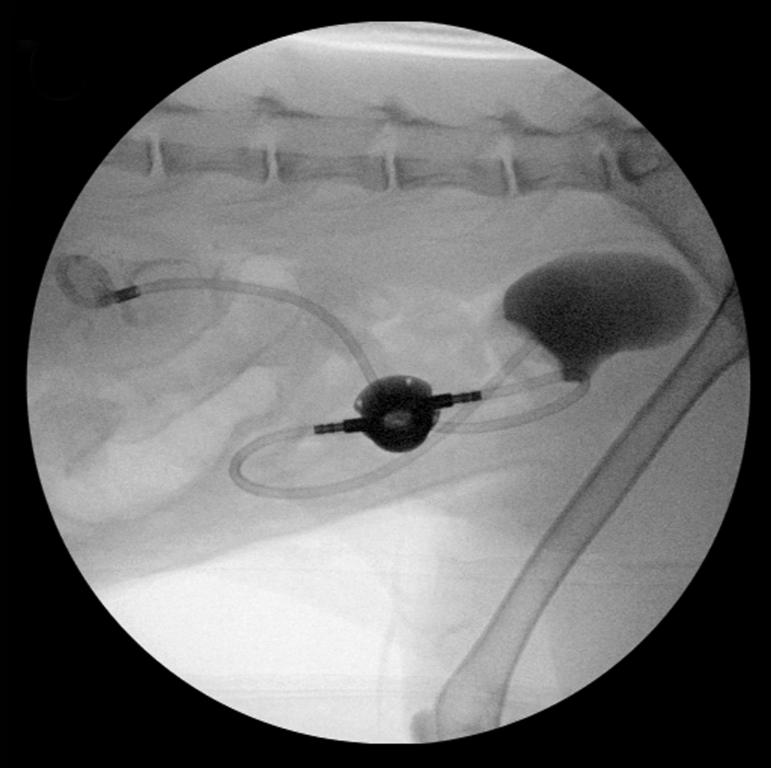
SUB Placement Associated With A High Complication Rate
A new study, published in the latest issue of the Journal of Small Animal Practice (JSAP), found that whilst subcutaneous ureteral bypass (SUB) placement was associated with a high complication rate, most complications were manageable, resulting in an overall median survival time of over two years.
The study, which was funded by BSAVA-PetSavers, the charitable division of the British Small Animal Veterinary Association showed that imaging techniques, such as fluoroscopy, were useful in identifying complications.
“Survival and complications in cats treated with subcutaneous ureteral bypass” reported complications and factors affecting outcome for cats following the placement of a subcutaneous ureteral bypass.
The medical records of cats that had been diagnosed with ureteral obstruction and had surgery to place a SUB between April 2012 and June 2017 were searched. Information recorded included imaging modality used for diagnosis, whether urethral catheterisation was performed and whether obstruction was uni- or bilateral.
Haematological and biochemical information recorded included packed cell volume (PCV), creatinine and potassium at presentation and discharge. Urine culture was performed either preoperatively via cystocentesis or intraoperatively through the catheter in the renal pelvis prior to SUB placement. Procedural information recorded included any technical complications, surgical time, anaesthesia time and whether a urinary catheter was placed.
Dr Nicola Kulendra, lead author for the paper said: “In this study, 95 cats had 130 SUBs placed. Minor complications – defined as infection or technical problem which resolved with none or minor treatment, not involving revision surgery, removal of the SUBs or death - occurred in 19% of patients. Major complications – defined as infection or technical problem resulting in revision surgery, removal of the SUBs or death/euthanasia – occurred in 48% of patients, the majority of which were after hospital discharge. Eleven per cent of cats did not survive to discharge.
“A significant association between long-term survival and creatinine at presentation was identified. The median survival time for cats presenting with creatinine concentration ≥440 μmol/L (International Renal Interest Society stage acute kidney injury (AKI) 4 and 5) was 530 days, compared to a median survival time of 949 days for those cats presenting with creatinine <440 μmol/L (International Renal Interest Society stage AKI 1–3).”
Nicola Di Girolamo, Editor of JSAP concluded: “Veterinary medicine is advancing fast and it is exciting to see treatment options that just a decade ago were rarely considered are now accessible to many of our patients. Furthermore it is excellent to see the veterinary sector is publishing articles of this nature, demonstrating the risks and complications of a procedure, to support proper discussion with owners and referring veterinarians.”
If kidneys are keeping you up at night, why not register for BSAVA’s Virtual Congress (25 to 27 March)? In the session ‘Nephroliths: when are they a problem and what should I do next?’ Isuru Gajanayake will be discussing identifying kidney stones, and Tim Charlesworth will be considering the surgical and medical approach to calcium oxalate nephroliths. Find out more here .
BSAVA-PetSavers is funded solely by charitable donations and has invested more than £2 million in vital clinical research and training programmes over the past 40 years to advance clinical investigations into pet animal medicine and surgery.
The full article can be found in the January issue of the Journal of Small Animal Practice and can be read online here. It is open access and can be freely accessed by anyone.
The Journal of Small Animal Practice is published monthly and access to articles is free for BSAVA members. For information on how to become a BSAVA member visit https://www.bsava.com/Membership/Member-categories
1N. J. Kulendra, K. Borgeat, H. Syme, H. Dirring and Z. Halfacree (2021) Survival and complications in cats treated with subcutaneous ureteral bypass. Journal of Small Animal Practice, 62 (1). Available at: https://onlinelibrary.wiley.com/doi/10.1111/jsap.13226
More from BSAVA
- BSAVA publishes new Guide to Procedures in Small Animal Practice
- BSAVA Bourgelat Award winner Nick Jeffery to discuss why veterinary medicine is a playground of uncertainty
- BSAVA PetSavers celebrates its 50th anniversary
- BSAVA PetSavers Launch Grant for Border Terrier Research
- BSAVA Launches its 2023 Awards

 3 years ago
3 years ago  937 views
937 views

 15 hours ago
15 hours ago